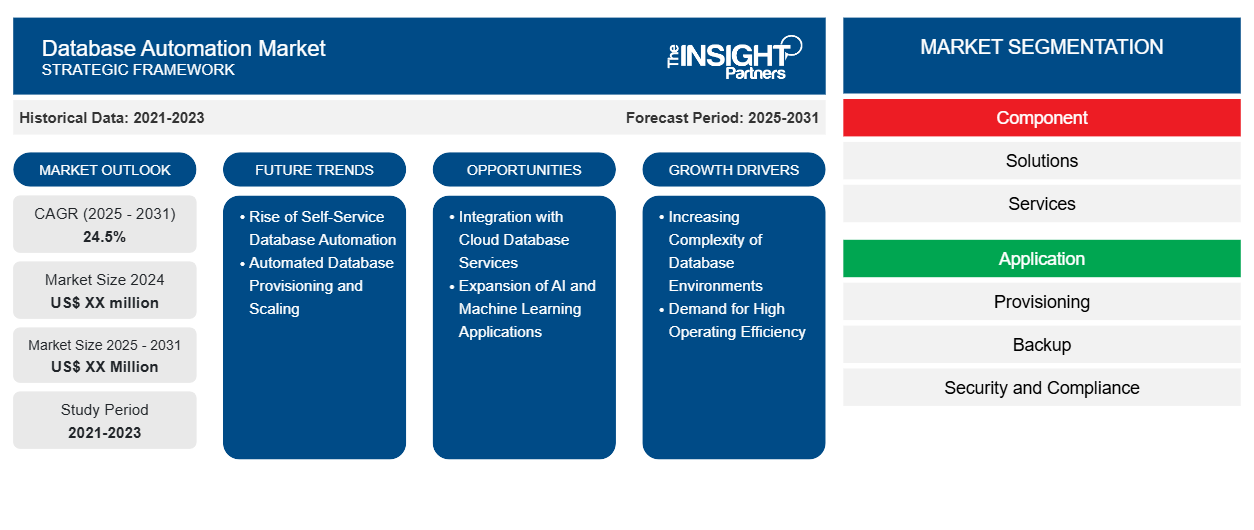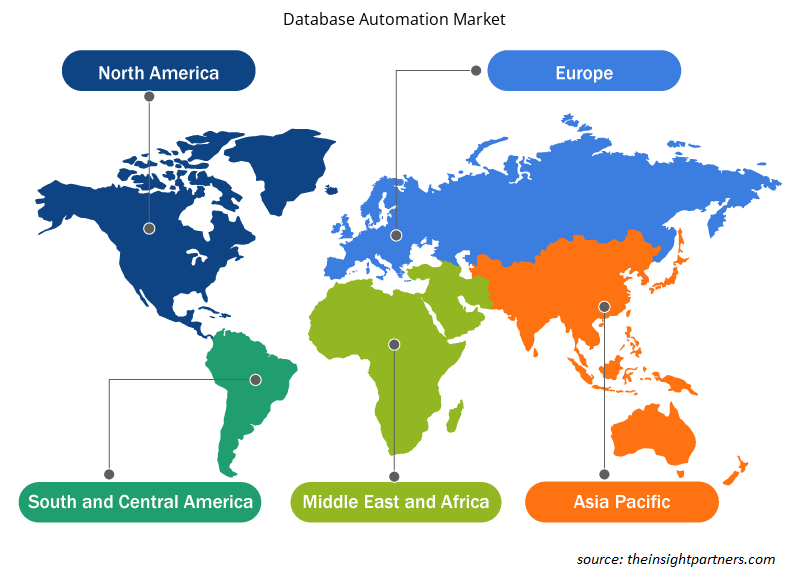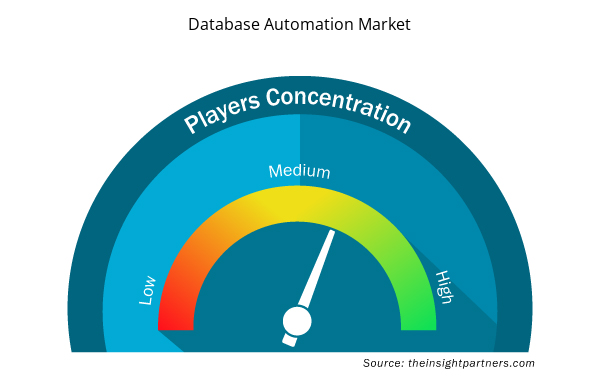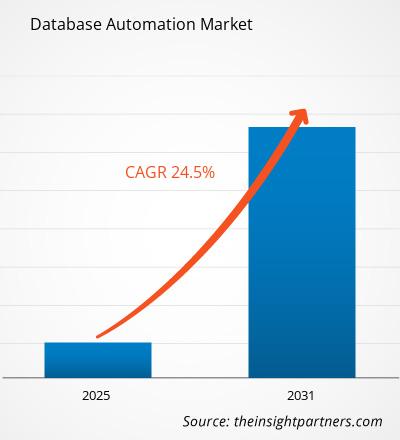データベース自動化市場は、2025年から2031年にかけて24.5%のCAGRで成長し、市場規模は2024年のXX百万米ドルから2031年にはXX百万米ドルに拡大すると予想されています。
レポートは、コンポーネント(ソリューション、サービス)、アプリケーション(プロビジョニング、バックアップ、セキュリティ、コンプライアンス)、展開モード(クラウド、オンプレミス)、企業規模(大企業、中小企業)、業種(製造、ヘルスケア、BFSI、研究・学術、メディア・エンターテイメント、小売・電子商取引、政府・防衛、通信・IT、その他)、地域(北米、ヨーロッパ、アジア太平洋、中東・アフリカ、南米・中米)別にセグメント化されています。
グローバル分析は、地域レベルと主要国別にさらに細分化されています。レポートでは、上記の分析とセグメントの値を米ドルで提供しています。
報告書の目的
The Insight Partners のデータベース自動化市場レポートは、現在の状況と将来の成長、主な推進要因、課題、機会を説明することを目的としています。これにより、次のようなさまざまなビジネス関係者に洞察が提供されます。
- テクノロジープロバイダー/メーカー: 進化する市場の動向を理解し、潜在的な成長機会を把握することで、情報に基づいた戦略的意思決定が可能になります。
- 投資家: 市場の成長率、市場の財務予測、バリュー チェーン全体に存在する機会に関する包括的な傾向分析を実施します。
- 規制機関: 市場の乱用を最小限に抑え、投資家の信用と信頼を維持し、市場の完全性と安定性を維持することを目的として、市場における政策と警察活動を規制します。
データベース自動化市場のセグメンテーション
成分
- ソリューション
- サービス
応用
- プロビジョニング
- バックアップ
- セキュリティとコンプライアンス
展開モード
- 雲
- オンプレミス
企業規模
- 大企業
- 中小企業
垂直
- 製造業
- 健康管理
- 英国
- 研究と学術
- メディアとエンターテイメント
- 小売業と電子商取引
- 政府と防衛
- 通信・IT
- その他
要件に合わせてレポートをカスタマイズする
このレポートの一部、国レベルの分析、Excelデータパックなど、あらゆるレポートを無料でカスタマイズできます。また、スタートアップや大学向けのお得なオファーや割引もご利用いただけます。
データベース自動化市場:戦略的洞察

- このレポートの主要な市場動向を入手してください。この無料サンプルには、市場動向から見積もりや予測に至るまでのデータ分析が含まれます。
データベース自動化市場の成長要因
- データベース環境の複雑化: 組織がマルチクラウドやハイブリッド環境など、より複雑なデータベース アーキテクチャを採用するにつれて、これらのシステムの管理はますます困難になっています。データベースの効果的な構成、監視、保守の必要性から、データベース自動化ソリューションの需要が高まっています。自動化ツールはデータベース管理タスクを合理化し、データベースの最適なパフォーマンス、セキュリティ、可用性を確保するために必要な手作業を削減します。この複雑さが、データベース自動化テクノロジの採用の主な原動力となっています。
- 高い運用効率の要求: 組織は常に運用効率の向上とデータベース管理に関連するコストの削減を目指しています。データベース管理における時間がかかり、エラーが発生しやすいプロセスは、運用のオーバーヘッドの増加につながります。組織は、データベース自動化ソリューションを通じて、バックアップ、パッチ適用、パフォーマンス チューニングなどの日常的なタスクからデータベース管理者を解放できます。運用効率の追求は、データベース自動化市場の成長の主な市場推進力です。
データベース自動化市場の将来動向
- セルフサービス データベース自動化の台頭: セルフサービス データベース自動化の傾向が高まっており、データベース ユーザーは IT チームに大きく依存することなく管理タスクを実行できます。セルフサービス プラットフォームを使用すると、ユーザーは直感的なインターフェイスとローコード/ノーコード ソリューションを通じて、プロビジョニング、スケーリング、パフォーマンス監視などの日常的なタスクを自動化できます。この傾向により、ビジネス ユニットはデータベース環境を所有できるようになり、俊敏性が向上し、ビジネス ニーズへの応答時間が短縮されます。
- 自動化されたデータベースのプロビジョニングとスケーリング: 自動化ツールは、需要に応じてデータベースを動的にプロビジョニングおよびスケーリングするためにますます使用されています。特にクラウドネイティブ データベースはこの傾向の恩恵を受け、データ負荷、トラフィック、またはリソース要件の変動に自動的に適応します。自動化されたプロビジョニングにより、データベースを手動で構成するのにかかる時間が短縮され、より迅速な展開が可能になります。さらに、スケーリングの自動化により、ユーザーの需要が増加してもデータベースのパフォーマンスが維持され、データベースのライフサイクル全体でコスト効率とリソース使用率が最適化されます。
データベース自動化の市場機会
- クラウド データベース サービスとの統合: クラウド コンピューティングへの移行は、データベース自動化市場に多くの機会をもたらします。組織がデータベースをクラウド環境に移行するにつれて、クラウド データベースをシームレスに操作できる自動化ソリューションの必要性が生まれます。クラウド サービス専用のデータベース自動化製品を提供する企業は、このような需要を最大限活用し、管理性を犠牲にすることなく、組織が拡張性と柔軟性、コスト削減のメリットを享受できるようにします。
- AI と機械学習アプリケーションの拡張: データベース自動化に AI と機械学習を組み込むと、予測メンテナンス、異常検出、最適化されたインテリジェントなデータ処理を通じてプロセスが促進されるため、大きな成長の余地があります。データベースの効率性と堅牢性を高めたいと考えている企業にはこのチャンスがあり、これにより他の市場エンティティよりも優位に立つことができます。
データベース自動化市場の地域別分析
予測期間を通じてデータベース自動化市場に影響を与える地域的な傾向と要因は、Insight Partners のアナリストによって徹底的に説明されています。このセクションでは、北米、ヨーロッパ、アジア太平洋、中東およびアフリカ、南米および中米にわたるデータベース自動化市場のセグメントと地理についても説明します。

- データベース自動化市場の地域別データを入手
データベース自動化市場レポートの範囲
| レポート属性 | 詳細 |
|---|---|
| 2024年の市場規模 | XX百万米ドル |
| 2031年までの市場規模 | XX百万米ドル |
| 世界のCAGR(2025年~2031年) | 24.5% |
| 履歴データ | 2021-2023 |
| 予測期間 | 2025-2031 |
| 対象セグメント | コンポーネント別
|
| 対象地域と国 | 北米
|
| 市場リーダーと主要企業プロフィール |
|
データベース自動化市場のプレーヤー密度: ビジネスダイナミクスへの影響を理解する
データベース自動化市場は、消費者の嗜好の変化、技術の進歩、製品の利点に対する認識の高まりなどの要因により、エンドユーザーの需要が高まり、急速に成長しています。需要が高まるにつれて、企業は提供内容を拡大し、消費者のニーズを満たすために革新を起こし、新たなトレンドを活用し、市場の成長をさらに促進しています。
市場プレーヤー密度とは、特定の市場または業界内で活動している企業または会社の分布を指します。これは、特定の市場スペースに、その規模または総市場価値と比較して、どれだけの競合相手 (市場プレーヤー) が存在するかを示します。
データベース自動化市場で事業を展開している主要企業は次のとおりです。
- Amazon Web Services, Inc.
- BMCソフトウェア株式会社
- データベイル
- DBマエストロ
- IBM
免責事項:上記の企業は、特定の順序でランク付けされていません。

- データベース自動化市場のトップキープレーヤーの概要を入手
主なセールスポイント
- 包括的なカバレッジ: レポートでは、データベース自動化市場の製品、サービス、タイプ、エンドユーザーの分析を包括的にカバーし、全体的な展望を提供します。
- 専門家による分析: レポートは、業界の専門家とアナリストの深い理解に基づいてまとめられています。
- 最新情報: このレポートは、最新の情報とデータの傾向を網羅しているため、ビジネスの関連性を保証します。
- カスタマイズ オプション: このレポートは、特定のクライアント要件に対応し、ビジネス戦略に適切に適合するようにカスタマイズできます。
したがって、データベース自動化市場に関する調査レポートは、業界のシナリオと成長の見通しを解読し理解する道の先導役となることができます。正当な懸念事項がいくつかあるかもしれませんが、このレポートの全体的な利点は欠点を上回る傾向があります。
- 過去2年間の分析、基準年、CAGRによる予測(7年間)
- PEST分析とSWOT分析
- 市場規模価値/数量 - 世界、地域、国
- 業界と競争環境
- Excel データセット


- Sodium Bicarbonate Market
- Railway Braking System Market
- Radiopharmaceuticals Market
- 3D Mapping and Modelling Market
- Procedure Trays Market
- Terahertz Technology Market
- Aesthetic Medical Devices Market
- Data Center Cooling Market
- Airport Runway FOD Detection Systems Market
- Single-Use Negative Pressure Wound Therapy Devices Market

Report Coverage
Revenue forecast, Company Analysis, Industry landscape, Growth factors, and Trends

Segment Covered
This text is related
to segments covered.

Regional Scope
North America, Europe, Asia Pacific, Middle East & Africa, South & Central America

Country Scope
This text is related
to country scope.
よくある質問
Some of the customization options available based on the request are an additional 3-5 company profiles and country-specific analysis of 3-5 countries of your choice. Customizations are to be requested/discussed before making final order confirmation# as our team would review the same and check the feasibility
The report can be delivered in PDF/PPT format; we can also share excel dataset based on the request
Rise of Self-Service Database Automation is anticipated to play a significant role in the global Database Automation Market in the coming years
Increasing Complexity of Database Environments and Demand for High Operating Efficiency are the major factors driving the Database Automation Market
The Database Automation Market is estimated to witness a CAGR of 24.5% from 2023 to 2031
Trends and growth analysis reports related to Technology, Media and Telecommunications : READ MORE..
- Amazon Web Services, Inc.
- BMC Software, Inc.
- Datavail
- DBmaestro
- IBM
- Micro Focus
- Microsoft
- Oracle
- Percona
- Severalnines AB
The Insight Partners performs research in 4 major stages: Data Collection & Secondary Research, Primary Research, Data Analysis and Data Triangulation & Final Review.
- Data Collection and Secondary Research:
As a market research and consulting firm operating from a decade, we have published and advised several client across the globe. First step for any study will start with an assessment of currently available data and insights from existing reports. Further, historical and current market information is collected from Investor Presentations, Annual Reports, SEC Filings, etc., and other information related to company’s performance and market positioning are gathered from Paid Databases (Factiva, Hoovers, and Reuters) and various other publications available in public domain.
Several associations trade associates, technical forums, institutes, societies and organization are accessed to gain technical as well as market related insights through their publications such as research papers, blogs and press releases related to the studies are referred to get cues about the market. Further, white papers, journals, magazines, and other news articles published in last 3 years are scrutinized and analyzed to understand the current market trends.
- Primary Research:
The primarily interview analysis comprise of data obtained from industry participants interview and answers to survey questions gathered by in-house primary team.
For primary research, interviews are conducted with industry experts/CEOs/Marketing Managers/VPs/Subject Matter Experts from both demand and supply side to get a 360-degree view of the market. The primary team conducts several interviews based on the complexity of the markets to understand the various market trends and dynamics which makes research more credible and precise.
A typical research interview fulfils the following functions:
- Provides first-hand information on the market size, market trends, growth trends, competitive landscape, and outlook
- Validates and strengthens in-house secondary research findings
- Develops the analysis team’s expertise and market understanding
Primary research involves email interactions and telephone interviews for each market, category, segment, and sub-segment across geographies. The participants who typically take part in such a process include, but are not limited to:
- Industry participants: VPs, business development managers, market intelligence managers and national sales managers
- Outside experts: Valuation experts, research analysts and key opinion leaders specializing in the electronics and semiconductor industry.
Below is the breakup of our primary respondents by company, designation, and region:

Once we receive the confirmation from primary research sources or primary respondents, we finalize the base year market estimation and forecast the data as per the macroeconomic and microeconomic factors assessed during data collection.
- Data Analysis:
Once data is validated through both secondary as well as primary respondents, we finalize the market estimations by hypothesis formulation and factor analysis at regional and country level.
- Macro-Economic Factor Analysis:
We analyse macroeconomic indicators such the gross domestic product (GDP), increase in the demand for goods and services across industries, technological advancement, regional economic growth, governmental policies, the influence of COVID-19, PEST analysis, and other aspects. This analysis aids in setting benchmarks for various nations/regions and approximating market splits. Additionally, the general trend of the aforementioned components aid in determining the market's development possibilities.
- Country Level Data:
Various factors that are especially aligned to the country are taken into account to determine the market size for a certain area and country, including the presence of vendors, such as headquarters and offices, the country's GDP, demand patterns, and industry growth. To comprehend the market dynamics for the nation, a number of growth variables, inhibitors, application areas, and current market trends are researched. The aforementioned elements aid in determining the country's overall market's growth potential.
- Company Profile:
The “Table of Contents” is formulated by listing and analyzing more than 25 - 30 companies operating in the market ecosystem across geographies. However, we profile only 10 companies as a standard practice in our syndicate reports. These 10 companies comprise leading, emerging, and regional players. Nonetheless, our analysis is not restricted to the 10 listed companies, we also analyze other companies present in the market to develop a holistic view and understand the prevailing trends. The “Company Profiles” section in the report covers key facts, business description, products & services, financial information, SWOT analysis, and key developments. The financial information presented is extracted from the annual reports and official documents of the publicly listed companies. Upon collecting the information for the sections of respective companies, we verify them via various primary sources and then compile the data in respective company profiles. The company level information helps us in deriving the base number as well as in forecasting the market size.
- Developing Base Number:
Aggregation of sales statistics (2020-2022) and macro-economic factor, and other secondary and primary research insights are utilized to arrive at base number and related market shares for 2022. The data gaps are identified in this step and relevant market data is analyzed, collected from paid primary interviews or databases. On finalizing the base year market size, forecasts are developed on the basis of macro-economic, industry and market growth factors and company level analysis.
- Data Triangulation and Final Review:
The market findings and base year market size calculations are validated from supply as well as demand side. Demand side validations are based on macro-economic factor analysis and benchmarks for respective regions and countries. In case of supply side validations, revenues of major companies are estimated (in case not available) based on industry benchmark, approximate number of employees, product portfolio, and primary interviews revenues are gathered. Further revenue from target product/service segment is assessed to avoid overshooting of market statistics. In case of heavy deviations between supply and demand side values, all thes steps are repeated to achieve synchronization.
We follow an iterative model, wherein we share our research findings with Subject Matter Experts (SME’s) and Key Opinion Leaders (KOLs) until consensus view of the market is not formulated – this model negates any drastic deviation in the opinions of experts. Only validated and universally acceptable research findings are quoted in our reports.
We have important check points that we use to validate our research findings – which we call – data triangulation, where we validate the information, we generate from secondary sources with primary interviews and then we re-validate with our internal data bases and Subject matter experts. This comprehensive model enables us to deliver high quality, reliable data in shortest possible time.

 このレポートの無料サンプルを入手する
このレポートの無料サンプルを入手する